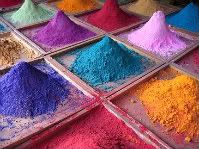
“Jack Sprat could eat no fat
His wife could eat no lean…”
When you’re painting, be like Jack, my fellow mini fans: Keep your paint lean.
If there’s one immediate thing that every painter should do as they strive to paint better minis, it’s thin their paint. Great globs of paint pulled right from the tube, eyedropper, or pot are not suitable to apply to your models. It’s simple: Thicker paint goes on more thickly and covers up or smooths over the precious tiny details of your miniature. Thick paint also doesn’t allow you to easily create effective layering and blending techniques.

Piles of pigment - not to be freebased
Did that make sense? Still with me? If not, don’t worry. The bottom line is simple- Thinning your paint is ultimately going to give you more control over how your paint goes onto the model. It’s a process that takes practice as varying the amount of water you use will allow you to achieve different effects. Different colors will also react differently to being thinned. Here are some general rules I like to follow:
- A wash of paint is about 15% paint and 85% water
- A standard application of paint is about 30% paint to 70% water – around the consistency of whole milk

Just playing around with thinning your paint is going to help make you a better painter. Make sure you are using a clean glass of water. It’s even nice to have a few cups of water out at a time: One completely clean and clear cup of water for mixing with the paint, one for cleaning brushes, and one for cleaning brushes with metallic paint so that it’s reflecting flakes don’t get into your other colors.
Controlling thinned paint creates some new challenges and can be frustrating, but here are a few tips to keep you from throwing that ForgeWorld Bloodthirster against the wall, boxing up the bits, and sending them all to my home address in anger (though I will happily retain them).
- Use a plastic water color palette or the like to hold your paint and water mixtures. I’m poor and eat a lot of spaghetti and use the lids from pasta sauce jars.
- You’ll often find it easiest to pull water directly from your clean cup and into a bit of paint. After you’ve used the brush to mix the water into the paint, immediately wipe your brush on a paper towel to clean all the excess paint off. Then put your brush back into the new mixture you’ve created and only take out a small amount. When you touch the brush to your model, the paint should go on thinly and not go on like big raindrops. Be patient and continuously dip your brush back into your thinned paint to pick up a small amount at a time.
- If you’re putting your paint on as described above, then each stroke should dry quickly, but don’t paint another layer on top of a previous one without allowing it to dry. Use a hairdryer on low if you have to.
- Another brush that is dry should be kept close by. Don't use this for putting paint onto the model. If too big a drop of watery paint forms on the model, you can suck up the excess with the trusty dry brush always at your side.
So there’s the tip of the week: thin every stroke of paint that touches your model with some amount of water! Please leave me a comment to let me know if this was useful to you or not. Any questions? Send those as well!







5 comments:
Nice simple explanation, although I would recommend having a brush that you only use for getting paint out of pots and mixing, never actually painting with this brush.
This will keep your painting brushes in better condition (hopefully).
Im guilty of not thining my paint enough. Excellent tips!
I am a huge fan of droppers for thinning paints. I have to say it was amazing to see the difference once I started thinning paints.
redboxtv
redbox tv
redboxtv app
redboxtv download
There are dozens of sites and applications that provide live TV streaming, ...
leapdroid apk
leapdroid for android
want to know more about other apps check our site.
Post a Comment